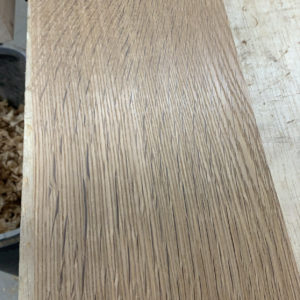I am curious if any one has experienced the color of medullary rays changing. I am making a dresser out of quarter sawn white oak and have been re-sawing 8/4 for drawer fronts. I now have a bunch of lumber that has very dark almost black ray flecks. The exterior of the board that was resawn has the typical white-ish ray flecks but the interior portion that is now exposed is very dark. I am hesitant to use the lumber because the flecks are not consistent in color with the rest of the piece. Will these flecks eventually lighten to the typical creamy white color?
Discussion Forum
Get It All!
UNLIMITED Membership is like taking a master class in woodworking for less than $10 a month.
Start Your Free TrialCategories
Discussion Forum
Digital Plans Library
Member exclusive! – Plans for everyone – from beginners to experts – right at your fingertips.
Highlights
-
Shape Your Skills
when you sign up for our emails
This site is protected by reCAPTCHA and the Google Privacy Policy and Terms of Service apply. -
 Shop Talk Live Podcast
Shop Talk Live Podcast -
 Our favorite articles and videos
Our favorite articles and videos -
E-Learning Courses from Fine Woodworking
-
-
 Fine Woodworking New England Event
Fine Woodworking New England Event -













Replies
Is it American white oak? If so, the ray flecks in that species do seem to vary more than they do in other oaks, both in colour and shape. (Have a look at images for medullary rays in google).
The function of the vessels that make those rays is to transport water, sap and all the things it contains across the radial axis of the tree. There can be all sorts of things in that sap, including various minerals and other compounds local to where the tree is growing. Some of them can presumably leave behind dyes or stains of colour. Perhaps there are also unusual chemical reactions between the tree tannin and something in the sap.
I've not seen that in oak I've had myself but that's mostly been European oaks.
Lataxe
Thanks for the reply! It’s the first time I have seen it white oak. I am going to hedge my bets and use pieces from the same board for all of the drawer fronts. It would look terrible to have five drawers with the dark rays and two with the typical cream colored rays.
I'm going with whatever was in the soil in that region. Matching up the drawer fronts sounds like the way to go.
Is anyone who'd point & giggle going to see the differences or just you blaming yourself?
Mikaol
I built several quarter sawn white oak doors in my house and one has a center panel that has that dark ray pattern. I just went to look at it to compare with your picture and could not find the dark rays anymore ! I then switched side and looked at it from a previous standpoint and the dark rays were back. I figure its a reflection of light and once finished, rays will either appear white or dark depending on light reflection.
Gulfstar,
That's interesting - about the medullary rays changing hue with different viewpoints. Something in them must be reflecting light in particular planes. This argues for something crystalline, with the most likely candidate being silica (silicone dioxide) as this is very common in the biological processes of many things and is found within trees of various species, often in large quantities.
As I understand it, silica compounds can contain all sorts of other things, which might give the base material other properties such as various colours and reflective indices.
The worst blunters of our sharp edges are often those timbers that contain a lot of silica. The worst rascal I know is iroko, which often contains not just the widely distributed teeny flecks but sometimes large "stones" that can blunt your bandsaw blade in seconds if you hit a one buried in a plank. That pictured revealed itself as I cut up an iroko plank when making a Veritas-style Adirondack chair.
****
That dark ray fleck could look rather good in the right setting. I could imagine it working well with oak given the black patinating wax treatment. A gothic aspect would result, perhaps.
Lataxe
Hi, Lataxe. I appreciate your opinion.
Oak can have dark streaks in the grain. I'm not sure why I'm assuming related to the tannin in the sap.
There are also different types of ray flecking the type of board you show there is one I normally don't use and that type of pattern seems to have more tendency to show the streaks.
Is it perfectly quarter sawn?
I just finished resawing several pieces of 8/4 quarter sawn white oak. The medullar rays on both sides of the 8/4 piece have white, creamy colored ray flecks. After sawing and opening it up for bookmatched pieces, the rays are a grayish brown. I can't figure out why this happens. Someone suggested it is from minerals or other natural substances that the tree absorbs. However, this does not explain why both surfaces have light colored ray flecks, and the inside of the board does not. They are along the same growth rings. Anyone who might have another explanation please chime in! Thanks.
This forum post is now archived. Commenting has been disabled